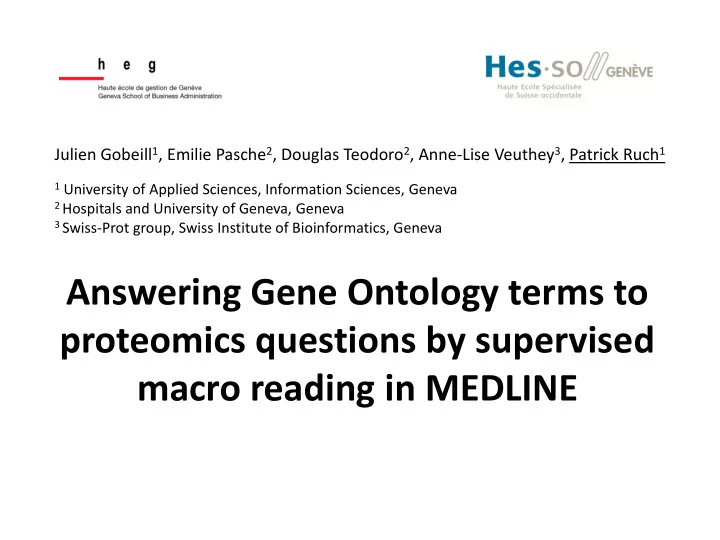

Julien Gobeill 1 , Emilie Pasche 2 , Douglas Teodoro 2 , Anne-Lise Veuthey 3 , Patrick Ruch 1 1 University of Applied Sciences, Information Sciences, Geneva 2 Hospitals and University of Geneva, Geneva 3 Swiss-Prot group, Swiss Institute of Bioinformatics, Geneva Answering Gene Ontology terms to proteomics questions by supervised macro reading in MEDLINE
Data deluge… “ What is the subcellular location of protein MEN1 ? ” “ What molecular functions are affected by Ryanodine ? ” 2
Ontology-based search engines 3
Question Answering (EAGLi system) Redundancy hypothesis: The number of associated/co-occurring answers dominate other dimensions
Best way for extracting GO terms from a set of abstracts ? (1/3) • Comparison based in two categorizers : – Thesaurus-Based (EAGL) • Competitive with MetaMap (Trieschnigg et al., 2009) • Compute lex. similarity between text and GO terms – Machine Learning (GOCat) • k -NN • Similarity between input text and already curated abstracts • KB derived from GOA : ~90’000 instances
Best way for extracting GO terms from a set of abstracts ? (2/3) • Two tasks : – Classical categorization (micro reading ~ biocuration) one GO terms abstract/paper – Redundancy-based QA (macro reading) a set of n (=100) Σ GO terms abstracts
Best way for extracting GO terms from a set of abstracts ? (3/3) • One benchmark for micro reading evaluation – 1’000 abstracts and GO descriptors from GOA • Two benchmarks for macro reading evaluation – 50 questions derived from a set of biological databases: What molecular functions are affected by [chemical] ? What cellular component is the location of [protein] ?
Results micro reading macro reading task task Benchmark 1’000 abstracts CTD UniProt Metrics P0 R10 P0 R100 P0 R10 EAGL (Thesaurus .23 .16 .34 .15 .33 .45 Based) GOCat .43 .47 .69 .33 .58 .73 (k-NN) (+86%) (+193%) (+102%) (+120%) (+75%) (+62%) + 75/120% for k-NN (sup. learning) Redundancy hypothesis insufficient Why/Where is the power ? Size does or does not matter ?
Deluge is self-compensated # terms in GO: +150% / 2003 # annotations with a PMID in 40000 GOA: + 100% / 2007 30000 300000 20000 200000 10000 100000 0 0 in 2007 in 2009 in 2011 in 2007 in 2009 in 2011 Performances of both categorizers Annotations in GOA for the top 5 across the time most contributing source 0,5 60000 Top precision 0,4 40000 0,3 EAGL 20000 0,2 0,1 0 1999 2002 2005 2008 2011 0 in 2007 in 2009 in 2011 MGI UniProtKB FlyBase Reactome TAIR
Deluge is self-compensated # terms in GO: +150% / 2003 # annotations with a PMID in 40000 GOA: + 100% / 2007 30000 300000 20000 200000 10000 100000 0 0 in 2007 in 2009 in 2011 in 2007 in 2009 in 2011 Categorization effectiveness moves Annotations in GOA for the top 5 faster than data most contributing source 0,5 60000 Top precision 0,4 40000 0,3 EAGL 20000 0,2 0,1 0 1999 2002 2005 2008 2011 0 in 2007 in 2009 in 2011 MGI UniProtKB FlyBase Reactome TAIR
Magic ! The automatic categorization based on a PMID 2007 performed in 2011 is of higher quality than a categorization on the same PMID 2007 performed in 2007 No concept drift at all and even some improvement!
Example in toxicogenomics: CTD vs. GOCat “ What molecular functions are affected by Ryanodine ? ” GOCat GO Rank GO Term GO Term Level 1. GO0005515 : protein binding 2. GO0005219 : ryanodine-sensitive calcium- GO0005219 : ryanodine-sensitive calcium- 9 release channel activity release channel activity 3. GO0005245 : voltage-gated calcium channel GO0015279 : calcium-release channel 7 activity activity 4. GO0005509 : calcium ion binding 7 GO0005262 : calcium channel activity 5. GO 0005262 : calcium channel activity 6 GO0022834 : ligand-gated channel activity 6. GO0005102 : receptor binding GO0015276 : ligand-gated ion channel 6 7. GO0005516 : calmodulin binding activity 8. GO0005388 calcium-transporting ATPase 3 GO0005516 : calmodulin binding activity 9. GO0015279 : calcium-release channel activity 10. GO0005528 : FK506 binding
Example in UniProt “ What is the subcellular location of protein MEN1 ? ” GOCat GO Rank GO Term GO Term Level 1. GO0005634 : nucleus GO0035097 : histone methyltransferase 2. GO0005737 : cytoplasm 6 complex 3. GO0005886 : plasma membrane 5 GO0000785 : chromatin 4. GO0005615 : extracellular space 5. GO0005887 : integral to plasma membrane 5 GO0016363 : nuclear matrix 6. GO0005739 : mitochondrion 4 GO0005829 : cytosol 7. GO0005829 : cytosol 3 GO0032154 : cleavage furrow 8. GO0005576 : extracellular region 9. GO0035097 : histone methyltransferase complex 10. GO0000785 : chromatin … 15. GO0016363 : nuclear matrix
Qualitative evaluation 40% Distribution of results 30% 20% 10% 0% Irrelevant General Relevant Highly relevant Relevance scale Relevant vs irrelevant : 82% - 18% Guha R., Gobeill J. and Ruch P. Automatic Functional Annotation of PubChem BioAssays
Conclusion and future work • Automatic assignment of GO categories ~ 43% [Camon et al 2003: GO kappa ~ 40%] • Classification model improves faster than drift [ Consistency of annotation guidelines ] • Next: Effective integration into the EAGLi ’ question-answering platform
Collaborations • Automatic Functional Annotation of PubChem BioAssays Generates semantic similarity clusters • Automatically populating large protein datasets Genes with unvalidated predicted functions
Please visit EAGLi, the Bio-medical question answering engine http://eagl.unige.ch/EAGLi/ !
The Gene Ontology Categorizer: http://eagl.unige.ch/GOCat/ Other resources… TWINC (patent retrieval…) http://bitem.hesge.ch
Acknowledgments • Swiss-prot group (SIB): Anne-Lise Veuthey, Yoannis Yenarios • U. Indiana/SCRIPPS: Rajarshi Guha / Stephan Schurer • The COMBREX project: Martin Steffen • NextProt: Pascale Gaudet • SNF Grant: EAGL # 120758 • EU FP7: www.KHRESMOI.eu # 257528
More recommend